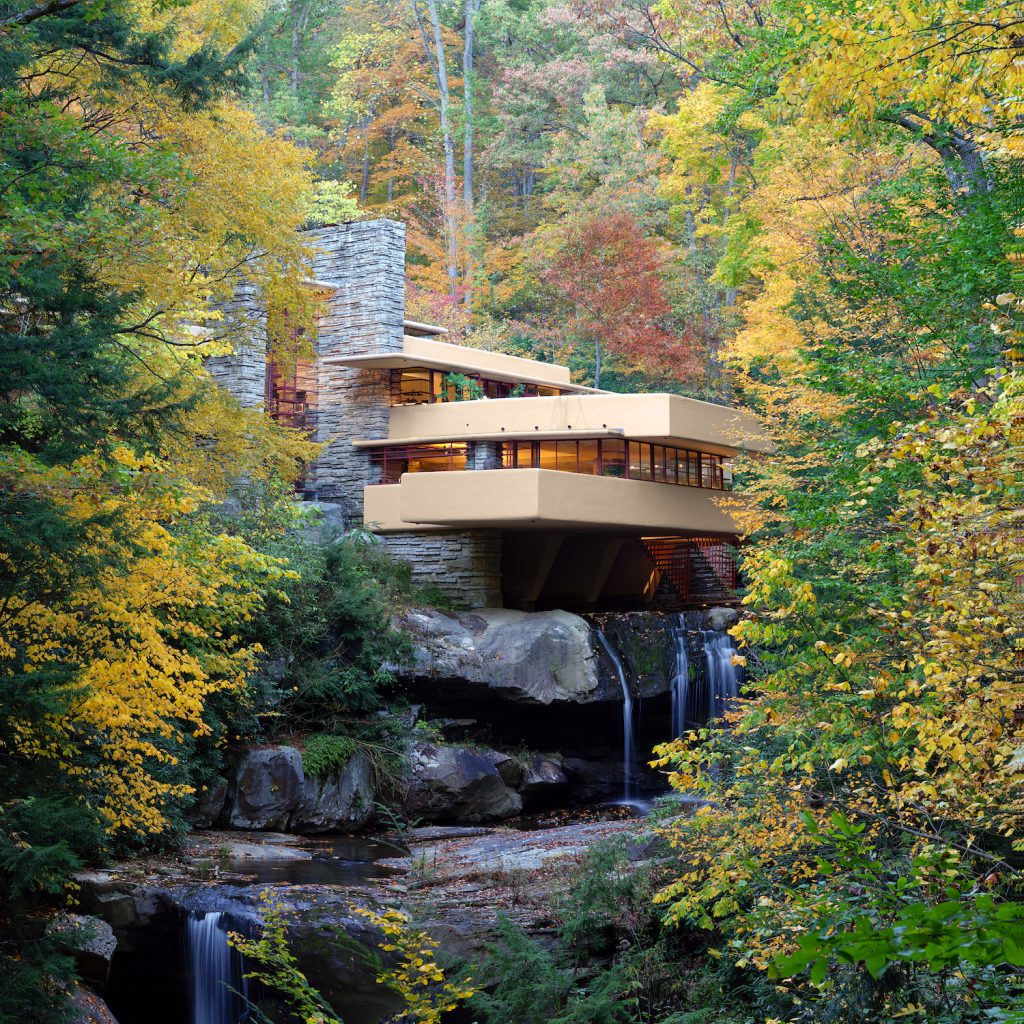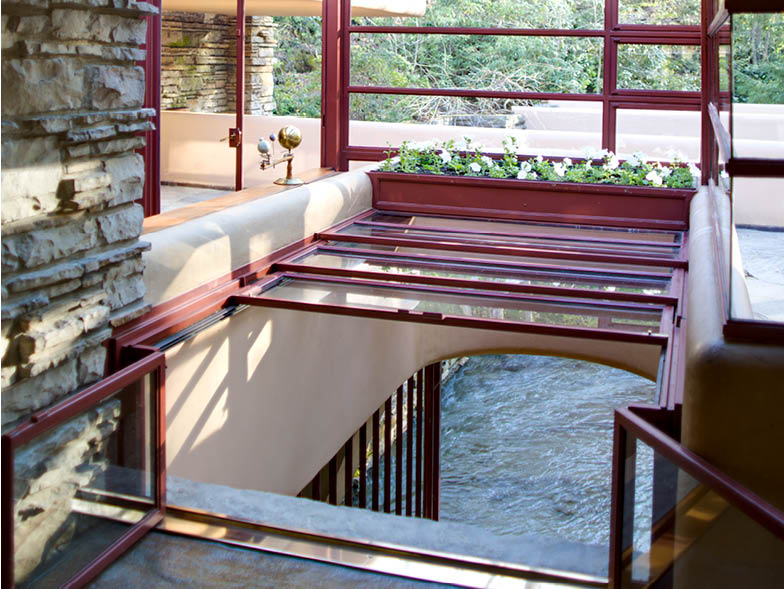Table Of Content

A view of the home interiors shows Wright’s signature concept of compression and openness, where small spaces lead to large open plan ones. Wright’s design suspended the home above the fall itself, filling the interiors with the powerful sound of rushing water. [Wright] understood that people were creatures of nature, hence an architecture which conformed to nature would conform to what was basic in people. For example, although all of Falling Water [sic] is opened by broad bands of windows, people inside are sheltered as in a deep cave, secure in the sense of the hill behind them. For the cantilevered floors, Wright and his team used upside-down T-shaped beams integrated into a monolithic concrete slab which formed both the ceiling of the space below and provided resistance against compression. The contractor, Walter Hall, also an engineer, produced independent computations and argued for increasing the reinforcing steel in the first floor's slab—Wright refused the suggestion.
Kaufmann Fallingwater House Frank Lloyd Wright Pittsburgh Ken Burns Frank Lloyd Wright Ken Burns - PBS
Kaufmann Fallingwater House Frank Lloyd Wright Pittsburgh Ken Burns Frank Lloyd Wright Ken Burns.
Posted: Fri, 29 Oct 2021 05:10:04 GMT [source]
You Cannot See the Waterfall from the House
On the West wall of the office there is a door which leads to the terrace, through which two trees were originally intended to grow. On the North face of the house, the opposite of that which “flies” over the river, there are two pergolas, like awnings, which run from the exterior wall to a stone incline and hang over the path which leads to the entrance. This means was utilised by Wright to make clear the respect for nature with which he designed the house.
Facts About Fallingwater That The Public Doesn't Know - House Digest
Facts About Fallingwater That The Public Doesn't Know.
Posted: Wed, 15 Jun 2022 07:00:00 GMT [source]
Western Pennsylvania Conservancy
Accounting for today’s inflation, the project’s construction would have racked up a price of $3.3 million, and Wright would have brought in $264,445 as its architect. The Kaufmanns planned to entertain large groups so the house needed to be larger than the original plot allowed. On entering the house by the main entrance, situated at the North face, we arrive at a small room which acts as a reception, located under the stairs which lead to the second floor. Past that room is the living room, the largest public room of the house from which there are splendid views of the woods which surround the house. On entering, we are faced by the “music corner”, whose etymology is unknown, to the right is the sofa area and behind the “music corner” is the “staircase of water”, so called because it leads down to a small platform beside the river.
In-Depth Guided Tour
The second is his Usonian houses, an urban planning concept for ideal living that consisted of neighborhoods of small L-shaped abodes with a strong indoor-outdoor connection. Concurrently with the design of Fallingwater, Wright was exploring designs for the Usonia house. Later, in the 1950s, he would plan America’s only district of such homes in Pleasantville, New York.
She received her B-tech degree in interior design from the University of Johannesburg in 2018 and has worked at various interior design firms since and had a few of her own freelance interior design clients under her company name binnekant. Although the terraces look like they are floating, they are anchored to the central chimney of the house through cantilevers. The idea of cantilevering the floors from a center point was inspired by pine branches. The square footage of the terraces of the house is almost the same as that of the indoor areas. By 1995 the house was in a very bad state, and on the brink of collapsing.
Fallingwater Institute Educational Programs
In 1997, emergency beams were installed, and the structure was properly restored in 2002. In 2019, Fallingwater, along with seven other buildings by Frank Lloyd Wright, was elected a UNESCO World Heritage Site. Kauffman donated the property in 1963 to the Western Pennsylvania Conservancy, as per his late father’s wishes. The doors were opened as a museum and have been a very popular site to visit for millions of people since. Artfilemagazine is your online art source, covering everything from artists, artworks, art periods, photography, and architecture to color theory. Artfilemagazine is your online art source, covering everything from artists, artworks, art history, painting, photography, and architecture to color theory.

Our Museum Store is Open
After some doubts and heated arguments, construction of Fallingwater began in 1936. Local craftsmen and labourers were hired, and materials were directly excavated from the Kaufmanns’ land. Fallingwater was mainly complete in 1937, with the family occupying the residence that fall. It quickly gained fame when Time magazine featured Wright and a drawing of the building on the cover of its January 17, 1938, issue. Indeed, Wright added a guest house to the site in 1939 to accommodate the Kaufmanns’ curious visitors.
Give to Fallingwater
Hopping in a rental car, we drove an hour and a half south through rolling hills and forests. Following a cathartic conversation about the challenges of parenthood, we talked about the origins of our interest in Wright. Was it a visit to his spiraling Guggenheim Museum, on Manhattan’s Upper East Side, or to the nearby Metropolitan Museum of Art, where the living room of Wright’s Francis W. Little House is preserved? Ben suggested it could have been the stained-glass windows emblazoned on mouse pads and mugs from museum-shop catalogues. The exterior of Fallingwater enforces a strong horizontal pattern with the bricks and long terraces. The windows on the facade have also have a special condition where they open up at the corners, breaking the box of the house and opening it to the vast outdoors.

Overall, this is not a huge drawback from a visit to Fallingwater in the grand scheme of things, but is something all visitors need to keep in mind as this one draws in the crowds from near and far. In a weird irony, the structure of the tour almost detracts from the flow of the house, and I can almost imagine Frank Lloyd Wright being furious at it all as the form of the tour is, in our opinion, the exact opposite of what he was going for. No matter when you visit, Fallingwater is crowded and tickets sell out sometimes weeks in advance. When planning a visit to Fallingwater, it is important to keep in mind that despite the fact that the house is located deep inside Ohiopyle State Park, it is one of the region's most popular attractions.
In addition, Fallingwater's structural system includes a series of very bold reinforced concrete cantilevered balconies. Pronounced deflection of the concrete cantilevers was noticed as soon as the formwork was removed during construction. This deflection increased over time, eventually reaching 7 inches (180 mm) over a 15 foot (4.6 m) span.
She also provided him with Froebel Gifts, which were very popular educational blocks part of an innovative kindergarten curriculum at the time. In his autobiography, Wright claims that these blocks were an integral part of his fascination with designing and building. Wright was born in Wisconsin on the 8th of June 1867, although he sometimes claimed that he was born in 1869.
Fallingwater is a house designed by the architect Frank Lloyd Wright in 1939 for the Kaufmann family as a weekend home. The main house uses 495 square meters (5,330 square feet) while the guest house uses 158 square meters (1,700 square feet). Secondly, the Prairie School was a form of architectural design that sought to produce structures that existed in harmony with the prairie landscapes of large swaths of the American continent. These two design principles would operate well alongside one another when he designed the structures that he designed. He also had a hand in the design of windows, furniture, interior design, and much more. And while he is best known for his many house designs, he did also design significantly more than just houses.
They often went for picnics at Bear Run and always dreamed out loud about having a holiday home there. The Kaufmann’s were also well known for their very popular Kaufmann’s department store. After leaving the company, Wright started his architectural firm and together with other young architects formed what is now known as the Prairie School.
He executed projects with a vision not only for aesthetic and function, but for family living as defined by the architecture itself. The architect designed almost 170 custom wood furnishings for the house in a style that blended harmoniously with the architecture. The living room flagstone floor blocks were individually tagged and removed. Blocks were joined to the concrete cantilever beams and floor joists; high-strength steel cables were fed through the blocks and exterior concrete walls and tightened using jacks.
Wright designed Fallingwater to rise above the waterfall over which it is built. Local craftsmen quarried native sandstone and other materials from the property and completed the construction of the main house, guest house and service wing in 1939. Designed in 1935 and completed in 1937, it is quite possible that Fallingwater just may be one of the most photographed, videoed, written about and talked about of Frank Lloyd Wright’s designs. Built over a waterfall, the house was supposed to serve as a weekend “retreat” for Edgar J. Kaufmann, Sr., the owner of a Pittsburgh, PA department store.
More than any other single work, Fallingwater signaled Wright’s return to preeminence in American architecture and initiated his final two decades of incredibly prolific practice. Though the late American architect designed more than 1,000 buildings during his career, Frank Lloyd Wright’s Fallingwater—a private home situated over an active waterfall in forested Mill Run, Pennsylvania—is one of his most celebrated. Considered a masterwork of the organic architecture style, Frank Lloyd Wright’s Fallingwater embodies a harmony between site and design that the architect championed. Critics raved after Fallingwater opened three years later, with Time magazine calling it Wright’s “most beautiful job” in a January 1938 cover story on the architect. Wright’s design is first and foremost a brilliant piece of site planning.
No comments:
Post a Comment